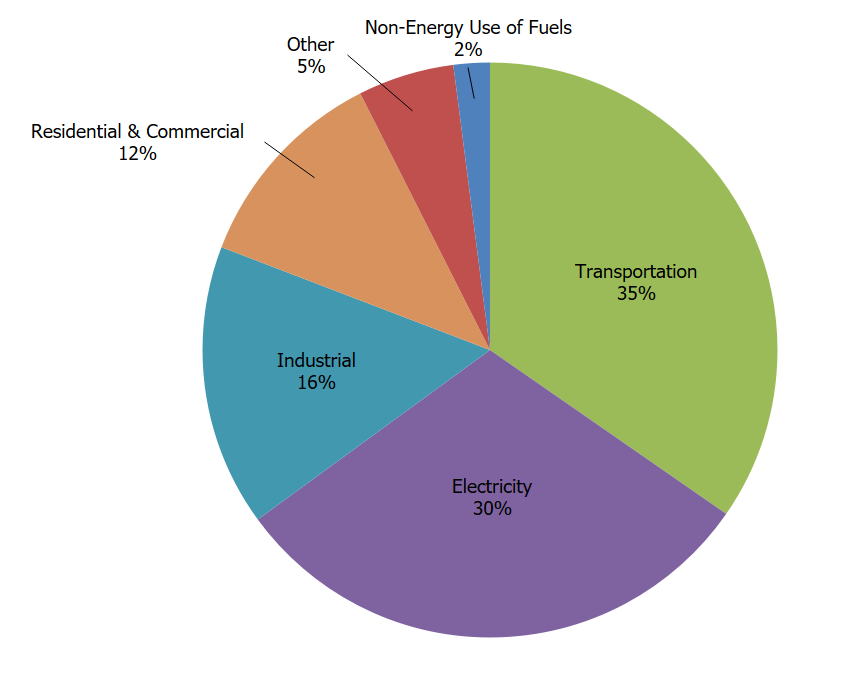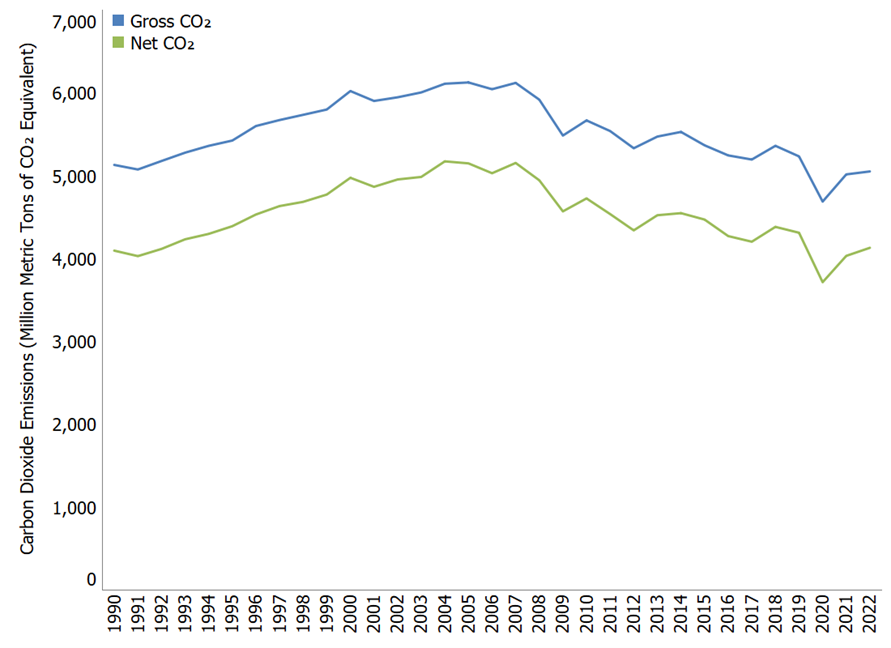Carbon Dioxide Emissions
Chemical Formula: CO2
Lifetime in Atmosphere: See reference1
Global Warming Potential (100-year): 1
On this page:
Sources of Carbon Dioxide Emissions
Carbon dioxide (CO2) is the primary greenhouse gas emitted through human activities. In 2022, CO2 accounted for 80% of all U.S. greenhouse gas emissions from human activities.
Carbon dioxide is naturally present in the atmosphere as part of the Earth's carbon cycle (the natural circulation of carbon among the atmosphere, oceans, soil, plants, and animals). Human activities are altering the carbon cycle, both by adding more CO2 to the atmosphere and by influencing the ability of natural sinks, like forests and soils, to remove and store CO2 from the atmosphere. While CO2 emissions come from a variety of natural sources, human-related emissions are responsible for the increase that has occurred in the atmosphere since the industrial revolution.2
The main human activity that emits CO2 is the combustion of fossil fuels (coal, natural gas, and oil) for energy and transportation. Certain industrial processes and land-use changes also emit CO2. The main sources of CO2 emissions in the United States are:
- Transportation. The combustion of fossil fuels such as gasoline and diesel to transport people and goods was the largest source of CO2 emissions in 2022, accounting for 35% of total U.S. CO2 emissions and 28% of total U.S. greenhouse gas emissions. This category includes domestic transportation sources such as highway and passenger vehicles, air travel, marine transportation, and rail.
- Electricity. Electricity is a key source of energy in the United States and is used to power homes, business, and industry. In 2022, the combustion of fossil fuels to generate electricity was the second largest source of CO2 emissions in the nation, accounting for 30% of total U.S. CO2 emissions and 24% of total U.S. greenhouse gas emissions. The types of fossil fuel used to generate electricity emit different amounts of CO2. To produce a given amount of electricity, burning coal will produce more CO2 than natural gas or oil.
- Industry. Many industrial processes emit CO2 through fossil fuel consumption. Several processes also produce CO2 emissions through chemical reactions that do not involve combustion, and examples include the production of mineral products such as cement, the production of metals such as iron and steel, and the production of chemicals. The fossil fuel combustion component of various industrial processes accounted for 16% of total U.S. CO2 emissions and 13% of total U.S. greenhouse gas emissions in 2022. Many industrial processes also use electricity and therefore indirectly result in CO2 emissions from electricity generation.
- Land Use, Land-Use Change, and Forestry (LULUCF). In the United States, the management of forests and other land (e.g., cropland, grasslands, etc.) has acted as a net sink of CO2, which means that more CO2 is removed from the atmosphere, and stored in plants and trees, than is emitted. This carbon sink offset about 13% of total emissions in 2022.
Carbon dioxide is constantly being exchanged among the atmosphere, ocean, and land surface as it is both produced and absorbed by many microorganisms, plants, and animals. Emissions and removals of CO2 by these natural processes, however, tend to balance over time, absent anthropogenic impacts. Since the Industrial Revolution began around 1750, human activities have contributed substantially to climate change by adding CO2 and other heat-trapping gases to the atmosphere.
To find out more about the role of CO2 in warming the atmosphere, visit the Climate Change Indicators page.
Carbon Dioxide Trends
Carbon dioxide emissions in the United States decreased by 1.5% between 1990 and 2022, excluding LULUCF sinks. Since the combustion of fossil fuel is the largest source of greenhouse gas emissions in the United States, changes in emissions from fossil fuel combustion have historically been the dominant factor affecting total U.S. emission trends. Changes in CO2 emissions from fossil fuel combustion are influenced by many long-term and short-term factors, including population growth, economic growth, changing energy prices, new technologies, changing behavior, and seasonal temperatures. In 2022, the increase in CO2 emissions from fossil fuel combustion corresponded with an increase in energy use as a result of economic activity rebounding after the height of the COVID-19 pandemic, in addition to an increase in coal use in the electric power sector.
Reducing Carbon Dioxide Emissions
The most effective way to reduce CO2 emissions is to reduce fossil fuel consumption. Many strategies for reducing CO2 emissions from energy are cross-cutting and apply to homes, businesses, industry, and transportation.
| Strategy | Examples of How Emissions Can be Reduced |
|---|---|
| Energy Efficiency |
Improving the insulation of buildings, traveling in more fuel-efficient vehicles, and using more efficient electrical appliances are all ways to reduce energy use, and thus CO2 emissions.
|
| Energy Conservation |
Reducing personal energy use by turning off lights and electronics when not in use reduces electricity demand. Reducing distance traveled in vehicles reduces petroleum consumption. Both are ways to reduce energy CO2 emissions through conservation. Learn more about What You Can Do at Home, at School, in the Office, and on the Road to save energy and reduce your carbon footprint. |
| Fuel Switching |
Producing more energy from renewable sources and using fuels with lower carbon contents are ways to reduce carbon emissions. |
| Carbon Capture and Sequestration (CCS) |
Carbon dioxide capture and sequestration is a set of technologies that can potentially greatly reduce CO2 emissions from new and existing coal- and gas-fired power plants, industrial processes, and other stationary sources of CO2. For example, a CCS project might capture CO2 from the stacks of a coal-fired power plant before it enters the atmosphere, transport the CO2 via pipeline, and inject the CO2 deep underground at a carefully selected and suitable subsurface geologic formation, such as a nearby abandoned oil field, where it is securely stored. |
| Changes in Uses of Land and Land Management Practices |
Learn more about Land Use, Land Use Change and Forestry Sector. |
References
1 Atmospheric CO2 is part of the global carbon cycle, and therefore its fate is a complex function of geochemical and biological processes. Some of the excess carbon dioxide will be absorbed quickly (for example, by the ocean surface), but some will remain in the atmosphere for thousands of years, due in part to the very slow process by which carbon is transferred to ocean sediments.
2IPCC (2021). Climate Change 2021: The Physical Science Basis. Contribution of Working Group I to the Sixth Assessment Report of the Intergovernmental Panel on Climate Change [Masson-Delmotte, V., P. Zhai, A. Pirani, S.L. Connors, C. Péan, S. Berger, N. Caud, Y. Chen, L. Goldfarb, M.I. Gomis, M. Huang, K. Leitzell, E. Lonnoy, J.B.R. Matthews, T.K. Maycock, T. Waterfield, O. Yelekçi, R. Yu, and B. Zhou (eds.)]. Cambridge University Press, Cambridge, United Kingdom and New York, NY, USA, 2391 pp.


